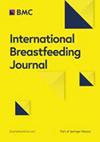哺乳期乳腺炎并发乳腺脓肿后因起搏器袋感染而逐步拔除经静脉导线
IF 2.9
2区 医学
Q1 OBSTETRICS & GYNECOLOGY
引用次数: 0
摘要
哺乳期乳腺炎是一种常见的乳腺组织炎症,会给患者带来疼痛和衰弱,一般采取保守治疗,或在乳腺脓肿的情况下进行脓液穿刺。然而,如果患者的乳房部位有植入性手术材料,治疗乳腺炎则极具挑战性。我们介绍了一例哺乳期母亲因心脏起搏器袋感染而并发哺乳期乳腺炎的罕见病例。一位 35 岁的依赖心脏起搏器的女性在产后七周患上了哺乳期乳腺炎。起初,她使用止痛药和抗生素进行保守治疗。脓肿形成后,使用细针抽吸技术吸出脓液。乳腺炎缓解四周后,出现了起搏器袋感染。根据目前的心血管植入式电子设备感染治疗指南,建议通过手术完全取出整个电子系统,然后进行有针对性的抗生素治疗,并在感染缓解后重新植入新的设备。然而,在与这位年轻女性及其家人进行充分讨论并详细了解手术相关风险后,她拒绝了这一潜在的高风险手术。因此,只切除了脉冲发生器,将起搏导线放置在胸骨下腔,在对侧植入了新的起搏器,并继续进行了为期六周的广谱抗生素治疗。停止母乳喂养后,由于心脏起搏器的主要植入部位出现了慢性瘘管,医生再次与她彻底讨论了延迟手术治疗的可能性,包括完全取出残留的心脏起搏器导线。经过深思熟虑后,患者同意了建议的治疗策略。手术过程包括使用手动双向旋转鞘通过主要植入静脉入口处进行经静脉导联抽取,手术非常成功,通过左锁骨下静脉入口处取出了所有残留导联,对侧起搏器功能完好且未感染。虽然主治医师和跨学科团队成员不鼓励患者在心血管植入式电子设备感染病例中决定延迟拔除,但我们的病例表明,对于有特殊要求、需求和/或临床需要的患者,分步治疗策略可能是成功的临床救助方案。本文章由计算机程序翻译,如有差异,请以英文原文为准。
Stepwise transvenous lead extraction due to pacemaker pocket infection following lactational mastitis complicated with breast abscess
Lactational mastitis is a common painful and debilitating inflammation of breast tissue, generally treated conservatively or with pus puncture in case of breast abscess. However, treating mastitis in patients with implantable surgical material located in the affected breast region can be extremely challenging. We present an unusual case of lactational mastitis complicated by pacemaker pocket infection in a breastfeeding mother. A 35-year-old pacemaker-dependent female developed lactational mastitis seven weeks postpartum. Initially, the condition was treated conservatively with analgesics and antibiotics. After abscess formation, pus was aspirated using fine-needle aspiration technique. Four weeks after mastitis resolution, pacemaker pocket infection developed. According to current cardiovascular implantable electronic device infection treatment guidelines a complete surgical extraction of the entire electronic system, followed by targeted antibiotic treatment and reimplantation of a new device after infection resolution, was recommended. However, after thorough discussion with the young woman and her family and after detailed review of surgery-related risks, she declined a potentially high-risk surgical procedure. Thus, only the pulse generator was explanted; pacing leads positioned in the sub-pectoral pocket; new pacemaker implanted on the contralateral side and broad-spectrum antibiotic therapy continued for six weeks. After breastfeeding cessation, and with chronic fistula development at the primary pacemaker implantation site, the possibility of delayed surgical intervention including complete extraction of retained pacemaker leads was again thoroughly discussed with her. After thoughtful consideration the woman consented to the proposed treatment strategy. A surgical procedure including transvenous lead extraction through the primary implantation venous entry site, using hand-powered bidirectional rotational sheaths, was successfully performed, removing all retained leads through the left subclavian venous entry site, and leaving the fully functional and clinically uninfected pacemaker on the contralateral site intact. Although patients’ decisions for delayed extraction in a case of cardiovascular implantable electronic device infection should be discouraged by attending physicians and members of interdisciplinary teams, our case shows that a stepwise treatment strategy may be successful as a bailout clinical scenario in patients with specific requests, demands and / or clinical needs.
求助全文
通过发布文献求助,成功后即可免费获取论文全文。
去求助
来源期刊

International Breastfeeding Journal
Medicine-Obstetrics and Gynecology
CiteScore
6.30
自引率
11.40%
发文量
76
审稿时长
32 weeks
期刊介绍:
Breastfeeding is recognized as an important public health issue with enormous social and economic implications. Infants who do not receive breast milk are likely to experience poorer health outcomes than breastfed infants; mothers who do not breastfeed increase their own health risks.
Publications on the topic of breastfeeding are wide ranging. Articles about breastfeeding are currently published journals focused on nursing, midwifery, paediatric, obstetric, family medicine, public health, immunology, physiology, sociology and many other topics. In addition, electronic publishing allows fast publication time for authors and Open Access ensures the journal is easily accessible to readers.
 求助内容:
求助内容: 应助结果提醒方式:
应助结果提醒方式:


